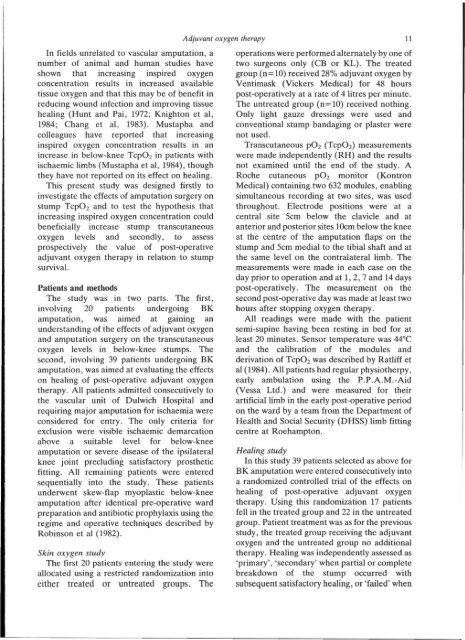View Complete Issue PDF
View Complete Issue PDF
View Complete Issue PDF
You also want an ePaper? Increase the reach of your titles
YUMPU automatically turns print PDFs into web optimized ePapers that Google loves.
In fields unrelated to vascular amputation, a<br />
number of animal and human studies have<br />
shown that increasing inspired oxygen<br />
concentration results in increased available<br />
tissue oxygen and that this may be of benefit in<br />
reducing wound infection and improving tissue<br />
healing (Hunt and Pai, 1972; Knighton et al,<br />
1984; Chang et al, 1983). Mustapha and<br />
colleagues have reported that increasing<br />
inspired oxygen concentration results in an<br />
increase in below-knee TcpO 2<br />
in patients with<br />
ischaemic limbs (Mustapha et al, 1984), though<br />
they have not reported on its effect on healing.<br />
This present study was designed firstly to<br />
investigate the effects of amputation surgery on<br />
stump TcpO 2<br />
and to test the hypothesis that<br />
increasing inspired oxygen concentration could<br />
beneficially increase stump transcutaneous<br />
oxygen levels and secondly, to assess<br />
prospectively the value of post-operative<br />
adjuvant oxygen therapy in relation to stump<br />
survival.<br />
Patients and methods<br />
The study was in two parts. The first,<br />
involving 20 patients undergoing BK<br />
amputation, was aimed at gaining an<br />
understanding of the effects of adjuvant oxygen<br />
and amputation surgery on the transcutaneous<br />
oxygen levels in below-knee stumps. The<br />
second, involving 39 patients undergoing BK<br />
amputation, was aimed at evaluating the effects<br />
on healing of post-operative adjuvant oxygen<br />
therapy. All patients admitted consecutively to<br />
the vascular unit of Dulwich Hospital and<br />
requiring major amputation for ischaemia were<br />
considered for entry. The only criteria for<br />
exclusion were visible ischaemic demarcation<br />
above a suitable level for below-knee<br />
amputation or severe disease of the ipsilateral<br />
knee joint precluding satisfactory prosthetic<br />
fitting. All remaining patients were entered<br />
sequentially into the study. These patients<br />
underwent skew-flap myoplastic below-knee<br />
amputation after identical pre-operative ward<br />
preparation and antibiotic prophylaxis using the<br />
regime and operative techniques described by<br />
Robinson et al (1982).<br />
Skin oxygen study<br />
The first 20 patients entering the study were<br />
allocated using a restricted randomization into<br />
either treated or untreated groups. The<br />
operations were performed alternately by one of<br />
two surgeons only (CB or KL). The treated<br />
group (n=10) received 28% adjuvant oxygen by<br />
Ventimask (Vickers Medical) for 48 hours<br />
post-operatively at a rate of 4 litres per minute.<br />
The untreated group (n=10) received nothing.<br />
Only light gauze dressings were used and<br />
conventional stump bandaging or plaster were<br />
not used.<br />
Transcutaneous pO 2<br />
(TcpO 2<br />
) measurements<br />
were made independently (RH) and the results<br />
not examined until the end of the study. A<br />
Roche cutaneous pO 2<br />
monitor (Kontron<br />
Medical) containing two 632 modules, enabling<br />
simultaneous recording at two sites, was used<br />
throughout. Electrode positions were at a<br />
central site 5cm below the clavicle and at<br />
anterior and posterior sites 10cm below the knee<br />
at the centre of the amputation flaps on the<br />
stump and 5cm medial to the tibial shaft and at<br />
the same level on the contralateral limb. The<br />
measurements were made in each case on the<br />
day prior to operation and at 1, 2, 7 and 14 days<br />
post-operatively. The measurement on the<br />
second post-operative day was made at least two<br />
hours after stopping oxygen therapy.<br />
All readings were made with the patient<br />
semi-supine having been resting in bed for at<br />
least 20 minutes. Sensor temperature was 44°C<br />
and the calibration of the modules and<br />
derivation of TcpO 2<br />
was described by Ratliff et<br />
al (1984). All patients had regular physiotherpy,<br />
early ambulation using the P.P.A.M.-Aid<br />
(Vessa Ltd.) and were measured for their<br />
artificial limb in the early post-operative period<br />
on the ward by a team from the Department of<br />
Health and Social Security (DHSS) limb fitting<br />
centre at Roehampton.<br />
Healing study<br />
In this study 39 patients selected as above for<br />
BK amputation were entered consecutively into<br />
a randomized controlled trial of the effects on<br />
healing of post-operative adjuvant oxygen<br />
therapy. Using this randomization 17 patients<br />
fell in the treated group and 22 in the untreated<br />
group. Patient treatment was as for the previous<br />
study, the treated group receiving the adjuvant<br />
oxygen and the untreated group no additional<br />
therapy. Healing was independently assessed as<br />
'primary', 'secondary' when partial or complete<br />
breakdown of the stump occurred with<br />
subsequent satisfactory healing, or 'failed' when
















